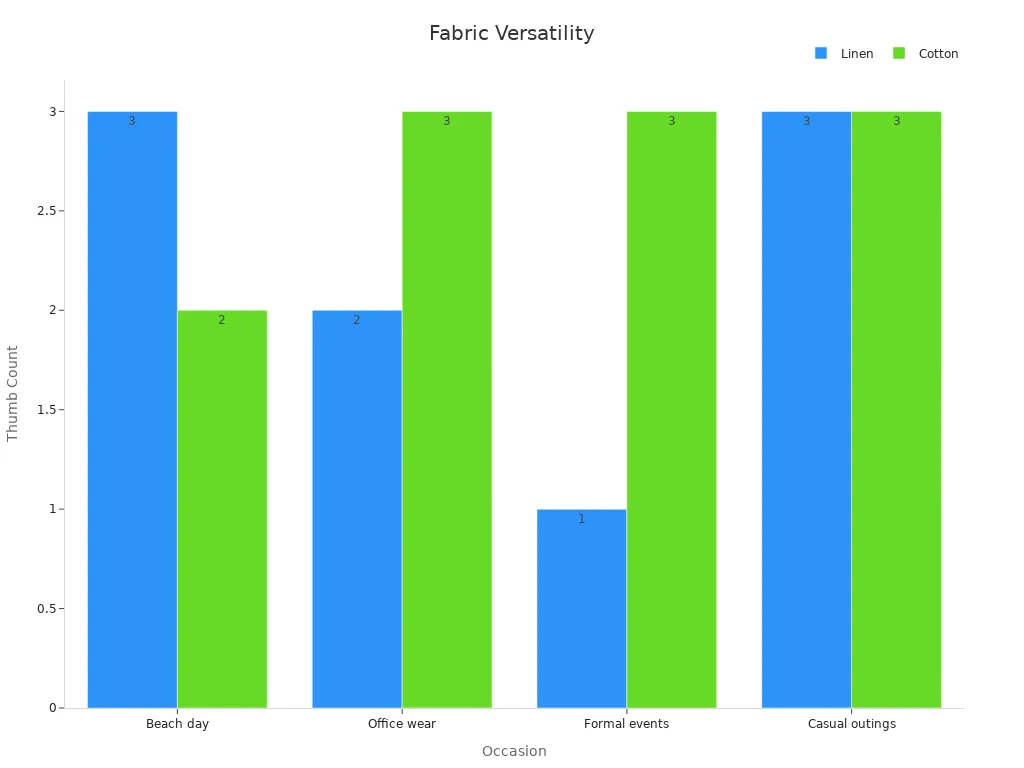
When summer hits, staying cool and comfortable becomes a top priority. Whether you’re lounging outdoors or working under the sun, the right fabric can make a world of difference.
Breathable fabrics allow air to circulate, helping your body stay fresh even on the hottest days. While natural materials like cotton and linen are lightweight, they typically offer lower UV protection—ranging from just 5 to 25. In contrast, certain polyester blends and high-tech fabrics like Luminora can block up to 98% of harmful UV rays.
So, how do you choose the right breathable fabric for summer clothing—especially if you’re buying in bulk? Let’s explore the pros and cons of the most common options and what to consider when sourcing materials for hot-weather wear.
Key Takeaways
- Pick fabrics like cotton, linen, and bamboo for summer. These let air pass through, keeping you cool and comfy.
- When buying lots of fabric, think about price, strength, and being eco-friendly. Good fabrics last longer and help the planet.
- Taking care of clothes makes them last longer. Wash them right and store them safely to avoid harm.
What Are the Top Breathable Fabrics for Summer Clothing?

Cotton
Cotton is a classic choice for summer. It’s lightweight, soft, and perfect for keeping you cool. This fabric allows air to flow freely, preventing sweat buildup and overheating. Plus, it’s gentle on sensitive skin, making it a favorite for all-day wear. Here’s a quick breakdown of why cotton works so well:
| Feature | Description |
|---|---|
| Breathable and Lightweight | Cotton allows airflow, preventing overheating and sweat buildup. |
| Moisture Absorption | It absorbs moisture, keeping you dry and comfortable. |
| Soft and Comfortable | Cotton feels gentle against the skin, ideal for sensitive skin types. |
Linen
Linen is another summer superstar. Made from flax fibers, it’s known for its durability and comfort in hot weather. Linen’s loose weave allows heat to escape, keeping you cool and dry. Here’s why it’s a go-to for summer:
- High strength and durability make it long-lasting.
- Excellent air circulation keeps you fresh.
- Lightweight and moisture-absorbing properties ensure comfort.
Bamboo
Bamboo fabric is a modern favorite for summer clothing. It’s incredibly breathable and wicks moisture away from your skin. This keeps you feeling fresh even on the hottest days. Bamboo also feels soft and luxurious, making it a great choice for sensitive skin.
- It has excellent moisture-wicking properties.
- Bamboo fibers allow air to circulate freely, preventing heat buildup.
- The fabric is soft, breathable, and gentle on the skin.
Rayon
Rayon is a versatile fabric that’s perfect for summer. It feels light and breezy, making it ideal for hot weather. Rayon also dries quickly, so you won’t feel sticky or uncomfortable. Here’s what makes it stand out:
- Quick-drying properties keep you comfortable.
- It’s nearly twice as absorbent as cotton, keeping your skin dry.
- Rayon allows air to circulate, enhancing breathability.
| Property | Description |
|---|---|
| Absorbency | Rayon is nearly twice as absorbent as cotton, helping to keep the skin dry. |
| Breathability | Rayon is a cool, breathable fabric that does not retain heat, ideal for summer. |
Chambray
Chambray is a lightweight fabric that looks like denim but feels much cooler. It’s a versatile option for summer clothing, offering both style and comfort. Whether it’s shirts, dresses, or shorts, chambray works for almost any outfit.
- Perfect for casual button-up shirts and dresses.
- Lightweight shorts offer breathability and comfort.
- Chambray is durable, making it great for children’s clothing and workwear.
Micromodal
Micromodal is a luxurious fabric that’s softer than cotton and highly breathable. It wicks moisture away from your skin, keeping you cool and dry. Here’s how it compares to cotton:
| Feature | Micromodal | Cotton |
|---|---|---|
| Softness | 3x softer than cotton | Standard softness |
| Texture | Silky feel | Regular feel |
| Breathability | High airflow, moisture-wicking | Moderate |
| Absorbency | 50% more absorbent than cotton | Standard absorbency |
Merino Wool
You might not think of wool for summer, but merino wool is different. It’s lightweight, breathable, and regulates your body temperature. This fabric wicks moisture away, keeping you cool when it’s hot and warm when it’s chilly.
- Hollow fibers wick moisture and allow air to circulate.
- Tiny air pockets trap air, enhancing breathability.
- Merino wool adjusts to your body’s needs, keeping you comfortable in any condition.
What Factors Should You Consider When Purchasing Breathable Fabrics in Bulk?
Cost and Budget
When buying breathable fabrics in bulk, setting a budget is your first step. Prices can vary widely depending on the fabric type and quality. For instance, premium options like bamboo or micromodal may cost more upfront but offer better performance and comfort. Tracking all expenses, including shipping fees, ensures you stay within your budget. Bulk purchasing often reduces costs, but don’t compromise on quality. Compare prices per yard and factor in shipping to make informed decisions.
- Tip: Consumers are willing to pay 25-35% more for fabrics with guaranteed durability. Investing in quality can save you money in the long run.
Durability and Longevity
Durability is key when purchasing fabrics in bulk, especially for summer clothing. Fabrics like linen and merino wool are known for their strength and long-lasting performance. Innovations like laser-cut TPU films can extend fabric lifespans by 300%, making them a smart choice for bulk orders. Here’s a quick look at durability metrics:
| Test Type | Minimum Requirements | Description |
|---|---|---|
| Tensile Strength | 800N x 800N | Measures stress a fabric can endure before breaking. |
| Abrasion Resistance | No yarn breakage after 30,000 revolutions | Assesses resistance to surface wear. |
| Pilling Resistance | Grade 4.0 after 7,000 cycles | Gauges resistance to small fibrous balls. |
Sustainability and Eco-Friendliness
Sustainability matters more than ever. Choosing eco-friendly fabrics like bamboo or organic cotton helps reduce your environmental footprint. Bamboo, for example, grows quickly and requires fewer resources than traditional crops. Linen is another sustainable option, as it’s biodegradable and made from flax, a renewable resource. By prioritizing eco-friendly materials, you contribute to a greener planet while offering high-quality clothing.
🌱 Note: Sustainable fabrics often come with certifications like GOTS (Global Organic Textile Standard) or OEKO-TEX, ensuring they meet environmental and safety standards.
Versatility for Different Clothing Styles
The versatility of breathable fabrics makes them ideal for various summer outfits. Cotton works well for casual wear, while linen shines in humid conditions. For formal events, micromodal offers a luxurious feel. Here’s a comparison of linen and cotton for different occasions:
| Occasion | Linen | Cotton |
|---|---|---|
| Beach day | 👍👍👍 | 👍👍 |
| Office wear | 👍👍 | 👍👍👍 |
| Formal events | 👍 | 👍👍👍 |
| Casual outings | 👍👍👍 | 👍👍👍 |

In coastal areas, linen’s quick-drying nature makes it a winner. For inland climates, cotton’s moisture retention keeps you comfortable. Choosing the right fabric ensures your clothing suits the occasion and environment.
How Can You Maintain and Care for Breathable Fabrics?

Proper Washing Techniques
Taking care of your breathable fabrics starts with washing them the right way. Each fabric has unique needs, so it’s important to follow specific guidelines to keep them looking and feeling great. Here’s a quick guide:
| Fabric Type | Care Instructions |
|---|---|
| Cotton | Machine wash with cold water; tumble dry low |
| Wool | Hand wash or dry clean; avoid heat |
| Silk | Dry clean recommended; avoid water |
| Polyester | Machine wash; low heat when drying |
| Linen | Machine wash; iron when damp to remove wrinkles |
For delicate fabrics like viscose, hand washing is your best bet. Submerge the fabric in cold water mixed with mild detergent, gently agitate it, and avoid wringing. Lay it flat on a towel to dry, away from direct sunlight or heat. Using cool water and a gentle cycle for machine-washable fabrics can also prevent shrinking and fading. Don’t forget to wash clothes inside out to protect colors and reduce wear.
Storing Fabrics to Prevent Damage
Proper storage is just as important as washing. Before putting your summer clothes away, make sure they’re clean. Stains left untreated can set over time, and dirt can attract pests. Store your garments in cool, dry spaces to avoid moisture damage. Use breathable garment bags instead of plastic covers to allow air circulation and prevent mildew.
For hanging clothes, choose padded or flocked hangers to avoid stretching delicate fabrics. If you’re storing items in containers, opt for organic cotton bags to protect them while allowing airflow. Adding humidity control measures, like silica gel packets, can help maintain the right conditions for your fabrics.
Avoiding Common Mistakes That Shorten Fabric Lifespan
Some common mistakes can ruin your fabrics faster than you think. Here’s how to avoid them:
- Don’t wring out wet clothes. This can stretch and weaken the fibers.
- Avoid using harsh detergents. Stick to pH-neutral options to preserve colors and texture.
- Skip the hot dryer. High heat can shrink and damage breathable fabrics.
- Limit sun exposure. Prolonged sunlight can fade colors and weaken fibers.
By following these tips, you’ll keep your summer wardrobe in top shape for years to come. Taking a little extra care now saves you time and money later!
Conclusion
Choosing the right fabric for summer clothing makes all the difference. Cotton, linen, bamboo, rayon, chambray, micromodal, and merino wool each offer unique benefits. For example, cotton is soft and breathable, while rayon excels in hot weather. Here’s a quick comparison to help you decide:
| Fabric | Breathability | Moisture Absorption | Comfort | Suitability for Hot Weather |
|---|---|---|---|---|
| Cotton | High | Good | Soft | Excellent |
| Rayon | Very High | Moderate | Comfortable | Excellent |
| Micromodal | High | Good | Soft | Very Good |
| Merino Wool | Moderate | Excellent | Comfortable | Good for evenings |
When buying in bulk, think about cost, durability, and sustainability. Investing in quality fabrics saves money over time and supports eco-friendly choices. Pick materials that balance comfort, style, and practicality. Your summer wardrobe—and your wallet—will thank you!
FAQ
What is the most affordable breathable fabric for bulk summer clothing?
Cotton is your best bet. It’s affordable, widely available, and offers excellent breathability for hot weather.
What makes bamboo fabric eco-friendly?
Bamboo grows quickly and needs fewer resources than other crops. It’s biodegradable and sustainable, making it a green choice for summer clothing.
What’s the easiest way to care for linen clothing?
Machine wash linen with cold water. Iron it while damp to remove wrinkles and keep it looking fresh.
